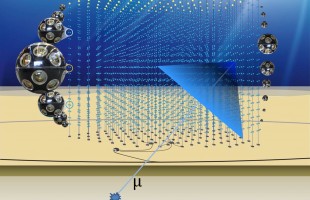The Dutch contribution to the neutrino telescope KM3NeT has received an investment grant of 12.7 Million Euro. KM3NeT is one of the ten top research facilities in NWO’s “National Roadmap for Large-scale Research Infrastructure”. Today, Minister Van Engelshoven, of Education, Culture and Science, issued the Roadmap certificates. The construction or renewal of these facilities has been given the highest priority.
This grant will give the completion of the neutrino telescope KM3NeT a big boost. KM3NeT is going to perform research into the fundamental properties of neutrinos and the astrophysical sources of cosmic neutrinos, and it will facilitate sea research and marine biology. The neutrino telescope will be placed deep in the Mediterranean Sea, the planned installation sites are off the shore near Toulon (France) and Sicily (Italy).
Since the start, the Netherlands has played an important role in this research. The applicants from Nikhef, together with NIOZ, TNO, KVI-CART, the University of Amsterdam, University Leiden, VU University and Radboud University, are very proud of the approval of this grant.
“The Dutch contributions are essential for the success of this international project”, says Stan Bentvelsen, Nikhef director. “Together with NIOZ, TNO and KVI-CART, Nikhef has designed nearly every component of the detector. We lead the construction of the detector, and play a crucial role in the research. With this fantastic grant, we can keep on doing this. This is a project we are very proud of.”
Els Koffeman, technical coordinator of KM3NeT and Nikhef researcher, is alsoenthusiastic: “Excellent! With this support we can make our plans a reality. We will fill a deep, large volume of water in the Mediterranean Sea with light sensitive detection units. We expect to detect the first neutrinos in 2020!”
“This funding will allow us to make KM3NeT a truly multi-disciplinary infrastructure of an unprecedented size”, says Paul de Jong, programme leader of the KM3NeT group at Nikhef. “KM3NeT will facilitate scientific breakthroughs in neutrino physics, neutrino astronomy, sea research and marine biology.”
Nikhef researcher Aart Heijboer, deputy spokesperson of KM3NeT, illustrates the opportunities for neutrino physics and neutrino astronomy: “Neutrinos are ghostly elementary particles that are produced in some of the most spectacular astrophysical regions, such as the centers of galaxies that house massive black holes. With KM3NeT, we will detect these neutrinos and pinpoint their sources, opening up a completely new way to study the Universe. Moreover, we can unravel the fundamental particle physics of neutrinos, which is important for understanding the evolution of the Universe.”
KM3NeT furthermore facilitates sea research and marine biology through temperature sensors and hydrophones which will be installed alongside the light sensitive detector units.
Hans van Haren, sea researcher at NIOZ, appreciates these opportunities: “KM3NeT offers to build a unique 3D network of 3000 high-resolution temperature sensors in a cubic hectometer of deep-sea to study essentially three-dimensional phenomena of internal wave turbulent mixing. This will enable new studies on the transport of matter, which has thus far only been done with measurements in one direction.“
Ernst-Jan Buis is involved in the project as a TNO researcher:” This project enables us to develop extremely sensitive hydrophone technology which can be used not only to study marine biology, but also to detect acoustic signals from neutrino interactions in water. Furthermore, the construction of such a complex network of detectors under such extreme conditions as present in the deep-sea, asks for special engineering skills. TNO, with its long-standing experiences in space-engineering, can contribute greatly to the construction of KM3NeT.”
KM3NeT is an international collaboration of 51 institutes and universities from 15 countries. The neutrino telescope KM3NeT is the successor of the smaller neutrino telescope ANTARES. At the moment, the construction of all detector components is well underway. The final KM3NeT neutrino telescope will consist of more than 300 strings, each with 18 light sensitive detector units, so-called Digital Optical Modules (DOMs). Beside this, KM3NeT will include a large network of temperature sensors and hydrophones. The Dutch research vessel Pelagia will be used to deploy the telescope in the sea. The sites in Toulon and Sicily are expected to be both fully deployed and operational in five years’ time.
More information
Vanessa Mexner, press officer Nikhef: v.mexner@nikhef.nl, +31 (0)20 592 2075
